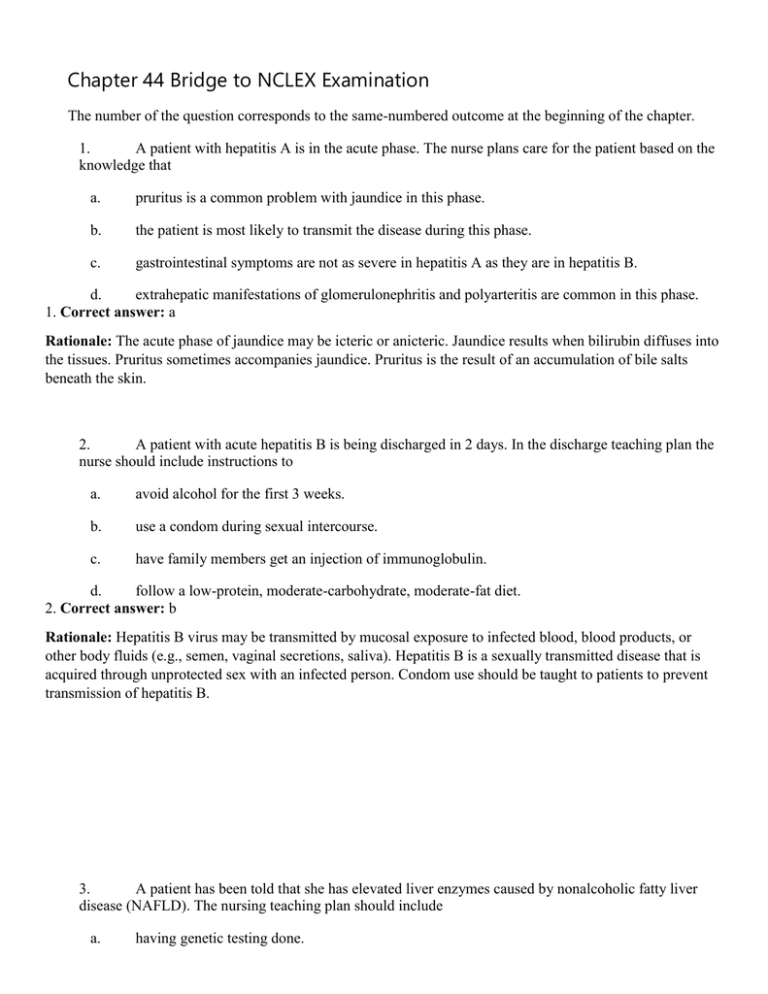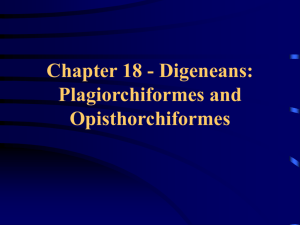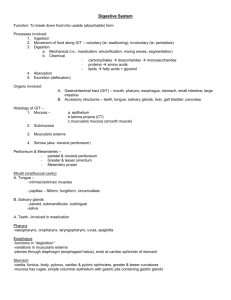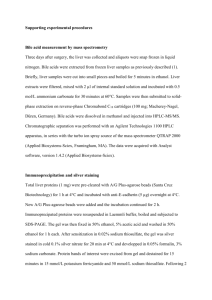Chapter 44 Bridge
advertisement

Chapter 44 Bridge to NCLEX Examination The number of the question corresponds to the same-numbered outcome at the beginning of the chapter. 1. A patient with hepatitis A is in the acute phase. The nurse plans care for the patient based on the knowledge that a. pruritus is a common problem with jaundice in this phase. b. the patient is most likely to transmit the disease during this phase. c. gastrointestinal symptoms are not as severe in hepatitis A as they are in hepatitis B. d. extrahepatic manifestations of glomerulonephritis and polyarteritis are common in this phase. 1. Correct answer: a Rationale: The acute phase of jaundice may be icteric or anicteric. Jaundice results when bilirubin diffuses into the tissues. Pruritus sometimes accompanies jaundice. Pruritus is the result of an accumulation of bile salts beneath the skin. 2. A patient with acute hepatitis B is being discharged in 2 days. In the discharge teaching plan the nurse should include instructions to a. avoid alcohol for the first 3 weeks. b. use a condom during sexual intercourse. c. have family members get an injection of immunoglobulin. d. follow a low-protein, moderate-carbohydrate, moderate-fat diet. 2. Correct answer: b Rationale: Hepatitis B virus may be transmitted by mucosal exposure to infected blood, blood products, or other body fluids (e.g., semen, vaginal secretions, saliva). Hepatitis B is a sexually transmitted disease that is acquired through unprotected sex with an infected person. Condom use should be taught to patients to prevent transmission of hepatitis B. 3. A patient has been told that she has elevated liver enzymes caused by nonalcoholic fatty liver disease (NAFLD). The nursing teaching plan should include a. having genetic testing done. b. recommending a heart-healthy diet. c. the necessity to reduce weight rapidly. d. avoiding alcohol until liver enzymes return to normal. 3. Correct answer: b Rationale: Nonalcoholic fatty liver disease (NAFLD) can progress to liver cirrhosis. There is no definitive treatment, and therapy is directed at reduction of risk factors, which include treatment of diabetes, reduction in body weight, and elimination of harmful medications. For patients who are overweight, weight reduction is important. Weight loss improves insulin sensitivity and reduces liver enzyme levels. No specific dietary therapy is recommended. However, a heart-healthy diet as recommended by the American Heart Association is appropriate. 4. The patient with advanced cirrhosis asks why his abdomen is so swollen. The nurse's response is based on the knowledge that a. a lack of clotting factors promotes the collection of blood in the abdominal cavity. b. portal hypertension and hypoalbuminemia cause a fluid shift into the peritoneal space. c. decreased peristalsis in the GI tract contributes to gas formation and distention of the bowel. d. bile salts in the blood irritate the peritoneal membranes, causing edema and pocketing of fluid. 4. Correct answer: b Rationale: Ascites is the accumulation of serous fluid in the peritoneal or abdominal cavity and is a common manifestation of cirrhosis. With portal hypertension, proteins shift from the blood vessels through the larger pores of the sinusoids (capillaries) into the lymph space. When the lymphatic system is unable to carry off the excess proteins and water, those substances leak through the liver capsule into the peritoneal cavity. Osmotic pressure of the proteins pulls additional fluid into the peritoneal cavity. A second mechanism of ascites formation is hypoalbuminemia, which results from the inability of the liver to synthesize albumin. Hypoalbuminemia results in decreased colloidal oncotic pressure. A third mechanism is hyperaldosteronism, which occurs when aldosterone is not metabolized by damaged hepatocytes. The increased level of aldosterone causes increases in sodium reabsorption by the renal tubules. Sodium retention and an increase in antidiuretic hormone levels cause additional water retention. 5. that In planning care for a patient with metastatic liver cancer, the nurse should include interventions a. focus primarily on symptomatic and comfort measures. b. reassure the patient that chemotherapy offers a good prognosis. c. promote the patient's confidence that surgical excision of the tumor will be successful. d. provide information necessary for the patient to make decisions regarding liver transplantation. 5. Correct answer: a Rationale: Nursing intervention for a patient with liver cancer focuses on keeping the patient as comfortable as possible. The prognosis for patients with liver cancer is poor. The cancer grows rapidly, and death may occur within 4 to 7 months as a result of hepatic encephalopathy or massive blood loss from gastrointestinal (GI) bleeding. 6. Nursing management of the patient with acute pancreatitis includes (select all that apply) a. checking for signs of hypocalcemia. b. providing a diet low in carbohydrates. c. giving insulin based on a sliding scale. d. observing stools for signs of steatorrhea. e. monitoring for infection, particularly respiratory tract infection. 6. Correct answers: a, e Rationale: During the acute phase, it is important to monitor vital signs. Hemodynamic stability may be compromised by hypotension, fever, and tachypnea. Intravenous fluids are ordered, and the response to therapy is monitored. Fluid and electrolyte balances are closely monitored. Frequent vomiting, along with gastric suction, may result in decreased levels of chloride, sodium, and potassium. Because hypocalcemia can occur in acute pancreatitis, the nurse should observe for symptoms of tetany, such as jerking, irritability, and muscular twitching. Numbness or tingling around the lips and in the fingers is an early indicator of hypocalcemia. The patient should be assessed for Chvostek’s sign or Trousseau’s sign. A patient with acute pancreatitis should be observed for fever and other manifestations of infection. Respiratory infections are common because the retroperitoneal fluid raises the diaphragm, which causes the patient to take shallow, guarded abdominal breaths. 7. A patient with pancreatic cancer is admitted to the hospital for evaluation of possible treatment options. The patient asks the nurse to explain the Whipple procedure that the surgeon has described. The explanation includes the information that a Whipple procedure involves a. creating a bypass around the obstruction caused by the tumor by joining the gallbladder to the jejunum. b. resection of the entire pancreas and the distal portion of the stomach, with anastomosis of the common bile duct and the stomach into the duodenum. c. removal of part of the pancreas, part of the stomach, the duodenum, and the gallbladder, with joining of the pancreatic duct, the common bile duct, and the stomach into the jejunum. d. radical removal of the pancreas, the duodenum, and the spleen, and attachment of the stomach to the jejunum, which requires oral supplementation of pancreatic digestive enzymes and insulin replacement therapy. 7. Correct answer: c Rationale: The classic operation for pancreatic cancer is a radical pancreaticoduodenectomy, or Whipple procedure. This entails resection of the proximal pancreas (i.e., proximal pancreatectomy), the adjoining duodenum (i.e., duodenectomy), the distal portion of the stomach (i.e., partial gastrectomy), and the distal segment of the common bile duct. The pancreatic duct, common bile duct, and stomach are anastomosed to the jejunum. 8. The nursing management of the patient with cholecystitis associated with cholelithiasis is based on the knowledge that a. shock-wave therapy should be tried initially. b. once gallstones are removed, they tend not to recur. c. the disorder can be successfully treated with oral bile salts that dissolve gallstones. d. laparoscopic cholecystectomy is the treatment of choice in most patients who are symptomatic. 8. Correct answer: d Rationale: Laparoscopic cholecystectomy is the treatment of choice for symptomatic cholelithiasis. 9. Teaching in relation to home management after a laparoscopic cholecystectomy should include a. keeping the bandages on the puncture sites for 48 hours. b. reporting any bile-colored drainage or pus from any incision. c. using over-the-counter antiemetics if nausea and vomiting occur. d. emptying and measuring the contents of the bile bag from the T tube every day. 9. Correct answer: b Rationale: The following discharge instructions are taught to the patient and caregiver after a laparoscopic cholecystectomy: First, remove the bandages on the puncture site the day after surgery and shower. Second, notify the surgeon if any of the following signs and symptoms occur: redness, swelling, bile-colored drainage or pus from any incision; and severe abdominal pain, nausea, vomiting, fever, or chills. Third, gradually resume normal activities. Fourth, return to work within 1 week of surgery. Fifth, resume a usual diet, but a low-fat diet is usually better tolerated for several weeks after surgery.








